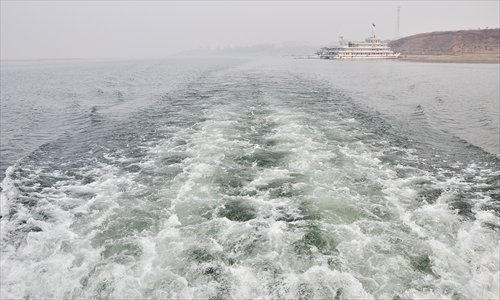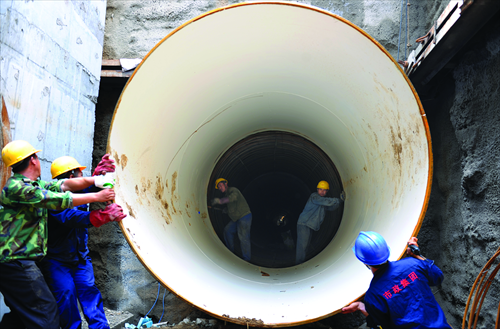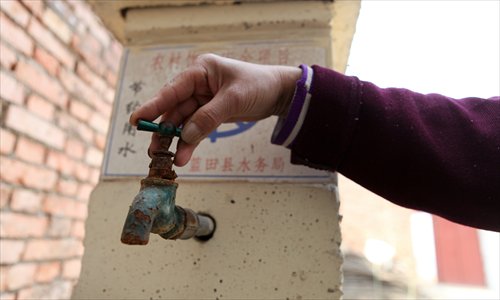HOME >> CHINA
Beijing readies for influx of new water from south
Source:Global Times Published: 2014-8-3 18:18:01
Capital readies for influx of new water from south

Danjiangkou Reservoir in Central China. Photo: CFP
In just 88 days, Beijing residents will finally be able to use the water from the South-to-North Water Diversion Project, a series of canals and pipes six decades in the making, designed to pull water from China's wet south to its arid north.
The middle route of the project, which officially began construction at the end of 2003, will open the flow gates at the end of October.
At that point, water diverted from Danjiangkou Reservoir in Hubei Province will reach most Beijing households through 20 water plants after 15 days of travel along 1,276 kilometers of canals and pipes.
If everything goes smoothly, the route will send 1.05 billion cubic meters of water to Beijing annually for the first several years of its operation, an amount equivalent to nearly 30 percent of the city's annual water consumption.
"Nearly all the rivers and lakes in Beijing are anticipating the water, which is hoped to bring some vitality to the stagnant water [sources around the capital]," Zhu Chendong, former chief engineer with the Beijing Water Authority, was quoted as saying in a recent report by Caijing magazine.
This hard-won water is expected to help relieve the city's water shortage and help repair local aquatic ecosystems.
Meanwhile, infrastructure years in the making, built in preparation of the water's arrival, will also face its first test.

Workers install underground water pipes for the South-to-North Water Diversion Project in Beijing, on June 18. Photo: CFP
Hardware prep
Previously, Beijing's water was supplied mainly from underground reserves and surface water in reservoirs north of the city. But with the arrival of water from Danjiangkou, these patterns will change.
The city began planning and constructing new water supply networks more than 10 years ago. Water from Danjiangkou will enter the city through Fangshan district in West Beijing into massive underground concrete pipes 4 meters in diameter.
After an 80 kilometer trip northward, across 32 rivers and streams, 12 main roads, 11 railroads and subway Line 1, the water will finally arrive at its terminal stop, Tuancheng Lake in the Summer Palace.
The lake, apart from being a water source for five major water plants in Beijing, is also a regulating pool for discharging and drawing water through a diversion canal connected to the Miyun Reservoir, the city's largest surface water resource.
To shorten the distance for other water plants accessing the water from the south, the city has also built a connection loop, laying pipes deep underground along almost the entire length of the city's Fifth Ring Road.
In order to adapt Beijing's water supply system to the water from the south, which is more acidic than the city's current supplies, the city laid or rust-proofed 2,200 kilometers of pipes, according to Hu Bo, an official from the Beijing Water Authority's water supply division.
The acidic water from the south could lead to yellow tap water in Beijing by eroding sediments accumulated in pipes that have seen decades of harder water.
This in fact happened early in 2008 after Beijing diverted water from southern parts of Hebei Province, when a number of households reported yellow running water.
Learning from this experience, the authorities have spent time figuring out how to adapt southern water to northern pipes, assembling scientists and experts in a small laboratory near the Danjiangkou Reservoir since 2009. The efforts have paid off, making sure that Beijing's water system will be able to handle the influx of southern water.
As part of the plan for introducing new water into the system, supplies diverted from the south will first mix with local water in water plants at a 1:4 ration. The ration will then be gradually adjusted until it reaches 1:1 at some point next year.
As part of its preparation efforts, the authorities have also built a production and storage center for emergency drinking water, with the capacity to provide drinking water for 500,000 people a day.

A water tap. Photo: CFP
Water recharge
The water diverted from the south will mainly be used for residential and industrial use in the city's central districts, although eventually water will be supplied to 15 of Beijing's administrative subdivisions (excepting only rural Yanqing county).
Portions of the water will also be set aside for ecological and environmental demand. One major consideration is recharging lakes and exhausted groundwater. Nevertheless, this idea has generated controversy over whether the water, obtained at price of 200 billion yuan ($32 billion) worth investment and the relocation of 340,000 people, will be realizing its true value if put to such a use.
According to official data, per-capita water resources in Beijing are below 100 cubic meters per person, less than 5 percent of the national average and barely one percent of the global average.
As it has pulled water from neighboring provinces, for years the city has also overexploited its groundwater. According to media reports, since 1980, a total of 21 rivers in the city have run dry, while 2,650 square meters of land have sunk to alarming degrees due to depletion of groundwater underneath.
"Groundwater overexploitation in the North China Plain is very serious and has been going on for more than 30 years. As much as 100 billion cubic meters of groundwater has been extracted, which means that we have nearly used up the water resources for posterity," lamented Xu Xinyi, dean of College of Sciences, Beijing Normal University, in an article by Caijing magazine.
The city's water authorities have confirmed that the arrival of southern water will also coincide with the gradual shutdown of thousands of private wells over the next five years. In addition, several groundwater recharge projects have been constructed. These efforts will bear fruit only gradually. Raising groundwater levels is difficult, and could take as long as a century due to low soil permeability.
"A stable and secure water supply for Beijing is the motivation for artificially recharging groundwater. If water volumes from the South-to-North Water Diversion Project are not sufficient to do so, we will have to prioritize residential demands [over other demands]," said Dai Yuhua, an official from the Beijing Water Authority.
Some experts have also suggested building water recycling facilities to reclaim and treat waste water before using it to recharge groundwater. And the city has, in fact, heeded this advice, building 25 water recycling plants.
To match its new water supply network, the water supply authority has also tweaked the rules around water supply and pricing, introducing a multi-tiered water pricing system that attempts to encourage people to make efficient use of water supplies.
On May 1, minimum water prices for residential users were raised to 5 yuan per cubic meters from 4 yuan, while the price for water-intensive users, including car washes, bath houses, golf courses and ski resorts was nearly tripled, to 160 yuan per cubic meters.
Car washes have been required to install water re-use equipment. Beijing's Xicheng district has listed water-intensive businesses as "unsuitable to urban core zones" and taken steps to limit their development in the district.
However, offences like illegally using groundwater or residential running water continue to be frequently reported.
In a June 28 report, The Beijing Times reported that more than 30 unlicensed car washes were under investigation for using groundwater. But no more than a half hour after law enforcement officials confiscated their tools and left, the owners had already restarted their business.
The owners said they've been in business for over 10 years, and that there is little for them to fear from law enforcement other than a fine of 10,000 to 5,000 yuan from the rare surprise inspection.
By paying 150 yuan to landlords for access to their private wells each month, the workshops can have unlimited use of the water. Such illegal workshops are not rare in Beijing.
Building awareness
Without educating the public on the importance of saving water, the South-to-North Water Diversion Project water will not close the gap on Beijing's water shortages as the population continues to increase.
"Our analysis is that the carrying capacity of water resources for Beijing is 12 million people. But, the city's population is already 20 million. What's more disturbing is that we hit that population figure 10 years earlier than we projected in our plans," Xu from Beijing Normal University was quoted as saying by 21st Century Business Herald.
While government officials and experts are alarmed by water shortages, Beijing residents have little sense of urgency. Xu noted that the government is hesitant to publicize the true situation, lest it affect social stability, adding that he has encouraged the government to tell the public the true severity of the challenges faced by Beijing's water supplies.
Zhang Guangdou, a water expert from Tsinghua University, has the same worries.
"You cry out that you're short of water, but regular people have no sense of it. All the time we see students on campus leave the water running on their taps," Zhang noted.
To conserve water for residential usage, the city has taken a number of steps, including cutting water quotas for agricultural and industrial usage and diverting water from neighboring regions.
Zero growth of water consumption in industries and negative growth in agriculture have been both successfully enforced in recent years. Beijing, which used to be a large producer of rice, has seen hundreds of square kilometers of rice paddies converted into dry land.
In order to meet demand for the capital city, Hebei Province, which is itself short of water resources, has given up half of its access to Miyun and Guanting reservoirs, two of Beijing's major water resources.
Experts say that it is now time for Beijing residents to get in the habit of saving water. Data show that Beijing's daily per-person domestic water consumption is 210 liters, much more than the 120 to 150 liters of the European countries.
Global Times - Agencies
Newspaper headline: Thirsty Beijing
Posted in: In-Depth